Alemanni
The Alemanni (also Alamanni;[1] Suebi "Swabians"[2]) were a confederation of Germanic tribes[3] on the Upper Rhine River. First mentioned by Cassius Dio in the context of the campaign of Caracalla of 213, the Alemanni captured the Agri Decumates in 260, and later expanded into present-day Alsace, and northern Switzerland, leading to the establishment of the Old High German language in those regions, by the eighth century named Alamannia.[4]
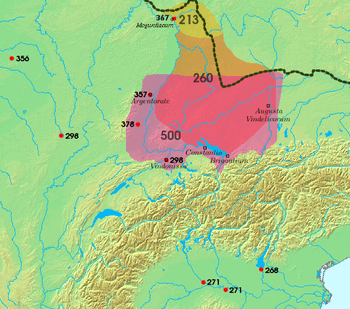
In 496, the Alemanni were conquered by Frankish leader Clovis and incorporated into his dominions. Mentioned as still pagan allies of the Christian Franks, the Alemanni were gradually Christianized during the seventh century. The Lex Alamannorum is a record of their customary law during this period. Until the eighth century, Frankish suzerainty over Alemannia was mostly nominal. After an uprising by Theudebald, Duke of Alamannia, though, Carloman executed the Alamannic nobility and installed Frankish dukes. During the later and weaker years of the Carolingian Empire, the Alemannic counts became almost independent, and a struggle for supremacy took place between them and the Bishopric of Constance. The chief family in Alamannia was that of the counts of Raetia Curiensis, who were sometimes called margraves, and one of whom, Burchard II, established the Duchy of Swabia, which was recognized by Henry the Fowler in 919 and became a stem duchy of the Holy Roman Empire.
The area settled by the Alemanni corresponds roughly to the area where Alemannic German dialects remain spoken, including German Swabia and Baden, French Alsace, German-speaking Switzerland, Liechtenstein and Austrian Vorarlberg.
The French language name of Germany, Allemagne, is derived from their name, from Old French aleman(t),[5] from French loaned into a number of other languages, including Middle English which commonly used the term Almains for Germans.[6][7] Likewise, the Arabic name for Germany is المانيا (Almania), the Spanish is Alemania, the Portuguese is Alemanha, Welsh is Yr Almaen and Persian is آلمان (Alman).
Name
According to Gaius Asinius Quadratus (quoted in the mid-sixth century by Byzantine historian Agathias), the name Alamanni (Ἀλαμανοι) means "all men". It indicates that they were a conglomeration drawn from various Germanic tribes.[8] The Romans and the Greeks called them as such mentioned. This derivation was accepted by Edward Gibbon, in his Decline and Fall of the Roman Empire[9] and by the anonymous contributor of notes assembled from the papers of Nicolas Fréret, published in 1753.[10] This etymology has remained the standard derivation of the name.[11] An alternative suggestion proposes derivation from *alah "sanctuary".[12]
Walafrid Strabo in the 9th century remarked, in discussing the people of Switzerland and the surrounding regions, that only foreigners called them the Alemanni, but that they gave themselves the name of Suebi.[13] The Suebi are given the alternative name of Ziuwari (as Cyuuari) in an Old High German gloss, interpreted by Jacob Grimm as Martem colentes ("worshippers of Mars").[14]
History
First appearance in historical record
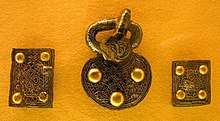
The Alemanni were first mentioned by Cassius Dio describing the campaign of Caracalla in 213. At that time, they apparently dwelt in the basin of the Main, to the south of the Chatti.[8]
Cassius Dio portrays the Alemanni as victims of this treacherous emperor.[15] They had asked for his help, according to Dio, but instead he colonized their country, changed their place names, and executed their warriors under a pretext of coming to their aid. When he became ill, the Alemanni claimed to have put a hex on him. Caracalla, it was claimed, tried to counter this influence by invoking his ancestral spirits.
In retribution, Caracalla then led the Legio II Traiana Fortis against the Alemanni, who lost and were pacified for a time. The legion was as a result honored with the name Germanica. The fourth-century fictional Historia Augusta, Life of Antoninus Caracalla, relates (10.5) that Caracalla then assumed the name Alemannicus, at which Helvius Pertinax jested that he should really be called Geticus Maximus, because in the year before he had murdered his brother, Geta.[16]
Through much of his short reign, Caracalla was known for unpredictable and arbitrary operations launched by surprise after a pretext of peace negotiations. If he had any reasons of state for such actions, they remained unknown to his contemporaries. Whether or not the Alemanni had been previously neutral, they were certainly further influenced by Caracalla to become thereafter notoriously implacable enemies of Rome.
This mutually antagonistic relationship is perhaps the reason why the Roman writers persisted in calling the Alemanni ”barbari," meaning "savages." The archaeology, however, shows that they were largely Romanized, lived in Roman-style houses and used Roman artifacts, the Alemannic women having adopted the Roman fashion of the tunica even earlier than the men.
Most of the Alemanni were probably at the time, in fact, resident in or close to the borders of Germania Superior. Although Dio is the earliest writer to mention them, Ammianus Marcellinus used the name to refer to Germans on the Limes Germanicus in the time of Trajan's governorship of the province shortly after it was formed, around 98-99 AD. At that time, the entire frontier was being fortified for the first time. Trees from the earliest fortifications found in Germania Inferior are dated by dendrochronology to 99-100 AD.
Ammianus relates (xvii.1.11) that much later the Emperor Julian undertook a punitive expedition against the Alemanni, who by then were in Alsace, and crossed the Main (Latin Menus), entering the forest, where the trails were blocked by felled trees. As winter was upon them, they reoccupied a "fortification which was founded on the soil of the Alemanni that Trajan wished to be called with his own name".[17]
In this context, the use of Alemanni is possibly an anachronism, but it reveals that Ammianus believed they were the same people, which is consistent with the location of the Alemanni of Caracalla's campaigns.
Alemanni and Hermunduri
Germania by Tacitus (AD 90) in Chapter 42 states that the Hermunduri were a tribe certainly located in the region that later became Thuringia. Tacitus states that they traded with Rhaetia, which in Ptolemy is located across the Danube from Germania Superior, suggesting that the Alemanni originally in part derived from the Hermunduri.
However, no Hermunduri appear in Ptolemy, though after the time of Ptolemy, the Hermunduri joined with the Marcomanni in the wars of 166–180 against the empire. Tacitus says that the source of the Elbe is among the Hermunduri, somewhat to the east of the upper Main. He places them also between the Naristi (Varisti), whose location was at the very edge of the Black Forest, and the Marcomanni and Quadi. Moreover, the Hermunduri were broken in the Marcomannic Wars and made a separate peace with Rome. The Alemanni thus were probably not primarily the Hermunduri, although some elements of them may have been present.
Ptolemy's Geography
Before the mention of Alemanni in the time of Caracalla, one would search in vain for Alemanni in the moderately detailed geography of southern Germany in Claudius Ptolemy, written in Greek in the mid-second century; at that time, the people who later used that name likely were known by other designations.[18]
Nevertheless, some conclusions can be drawn from Ptolemy. Germania Superior is easily identified. Following up the Rhine one comes to a town, Mattiacum, which must be at the border of the Roman Germany (vicinity of Wiesbaden). Upstream from it and between the Rhine and Abnoba (in the Black Forest) are the Ingriones, Intuergi, Vangiones, Caritni and Vispi, some of whom were there since the days of the early empire or before. On the other side of the northern Black Forest were the Chatti about where Hesse is today, on the lower Main.
Historic Swabia was eventually replaced by today's Baden-Württemberg, but it had been the most significant territory of mediaeval Alamannia, comprising all Germania Superior and territory east to Bavaria. It did not include the upper Main, but that is where Caracalla campaigned. Moreover, the territory of Germania Superior was not originally included among the Alemanni's possessions.
However, if one looks for the peoples in the region from the upper Main in the north, south to the Danube and east to the Czech Republic where the Quadi and Marcomanni were located, Ptolemy does not give any tribes. The Tubanti are just south of the Chatti and at the other end of what was then the Black Forest, the Varisti, whose location is known. One possible reason for this distribution is that the population preferred not to live in the forest except in troubled times. The region between the forest and the Danube, though, included about a dozen settlements, or "cantons".
Ptolemy's view of Germans in the region indicates that the tribal structure had lost its grip in the Black Forest region and was replaced by a canton structure. The tribes stayed in the Roman province, perhaps because the Romans offered stability. Also, Caracalla perhaps felt more comfortable about campaigning in the upper Main because he was not declaring war on any specific historic tribe, such as the Chatti or Cherusci, against whom Rome had suffered grievous losses. By Caracalla's time, the name Alemanni was being used by cantons themselves banding together for purposes of supporting a citizen army (the "war bands").
Concentration of Germanic peoples under Ariovistus
The term Suebi has a double meaning in the sources. On the one hand Tacitus' Germania tells us (Chapters 38, 39) that they occupy more than half of Germany, use a distinctive hair style, and are spiritually centered on the Semnones. On the other hand, the Suebi of the upper Danube are described as though they were a tribe.
The solution to the puzzle as well as explaining the historical circumstances leading to the choice of the Agri Decumates as a defensive point and the concentration of Germans there are probably to be found in the German attack on the Gallic fortified town of Vesontio in 58 BC. The upper Rhine and Danube appear to form a funnel pointing straight at Vesontio.
Julius Caesar in Gallic Wars tells us (1.51) that Ariovistus had gathered an army from a wide region of Germany, but especially the Harudes, Marcomanni, Triboci, Vangiones, Nemetes and Sedusii. The Suebi were being invited to join. They lived in 100 cantons (4.1) from which 1000 young men per year were chosen for military service, a citizen-army by our standards and by comparison with the Roman professional army.
Ariovistus had become involved in an invasion of Gaul, which the German wished to settle. Intending to take the strategic town of Vesontio, he concentrated his forces on the Rhine near Lake Constance, and when the Suebi arrived, he crossed. The Gauls had called to Rome for military aid. Caesar occupied the town first and defeated the Germans before its walls, slaughtering most of the German army as it tried to flee across the river (1.36ff). He did not pursue the retreating remnants, leaving what was left of the German army and their dependents intact on the other side of the Rhine.
The Gauls were ambivalent in their policies toward the Romans. In 53 BC the Treveri broke their alliance and attempted to break free of Rome. Caesar foresaw that they would now attempt to ally themselves with the Germans. He crossed the Rhine to forestall that event, a successful strategy. Remembering their expensive defeat at the Battle of Vesontio, the Germans withdrew to the Black Forest, concentrating there a mixed population dominated by Suebi. As they had left their tribal homes behind, they probably took over all the former Celtic cantons along the Danube.
Conflicts with the Roman Empire
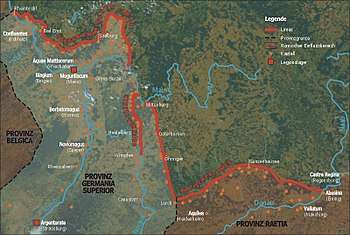
The Alemanni were continually engaged in conflicts with the Roman Empire in the 3rd and 4th centuries. They launched a major invasion of Gaul and northern Italy in 268, when the Romans were forced to denude much of their German frontier of troops in response to a massive invasion of the Goths from the east. Their raids throughout the three parts of Gaul were traumatic: Gregory of Tours (died ca 594) mentions their destructive force at the time of Valerian and Gallienus (253–260), when the Alemanni assembled under their "king", whom he calls Chrocus, who "by the advice, it is said, of his wicked mother, and overran the whole of the Gauls, and destroyed from their foundations all the temples which had been built in ancient times. And coming to Clermont he set on fire, overthrew and destroyed that shrine which they call Vasso Galatae in the Gallic tongue," martyring many Christians (Historia Francorum Book I.32–34). Thus 6th-century Gallo-Romans of Gregory's class, surrounded by the ruins of Roman temples and public buildings, attributed the destruction they saw to the plundering raids of the Alemanni.
In the early summer of 268, the Emperor Gallienus halted their advance into Italy, but then had to deal with the Goths. When the Gothic campaign ended in Roman victory at the Battle of Naissus in September, Gallienus' successor Claudius Gothicus turned north to deal with the Alemanni, who were swarming over all Italy north of the Po River.
After efforts to secure a peaceful withdrawal failed, Claudius forced the Alemanni to battle at the Battle of Lake Benacus in November. The Alemanni were routed, forced back into Germany, and did not threaten Roman territory for many years afterwards.
Their most famous battle against Rome took place in Argentoratum (Strasbourg), in 357, where they were defeated by Julian, later Emperor of Rome, and their king Chnodomarius was taken prisoner to Rome.[8]
On January 2, 366, the Alemanni yet again crossed the frozen Rhine in large numbers, to invade the Gallic provinces, this time being defeated by Valentinian (see Battle of Solicinium). In the great mixed invasion of 406, the Alemanni appear to have crossed the Rhine river a final time, conquering and then settling what is today Alsace and a large part of the Swiss Plateau.[8] The crossing is described in Wallace Breem's historical novel Eagle in the Snow. The Chronicle of Fredegar gives the account. At Alba Augusta (Alba-la-Romaine) the devastation was so complete, that the Christian bishop retired to Viviers, but in Gregory's account at Mende in Lozère, also deep in the heart of Gaul, bishop Privatus was forced to sacrifice to idols in the very cave where he was later venerated. It is thought this detail may be a generic literary ploy to epitomize the horrors of barbarian violence.
List of battles between Romans and Alemanni
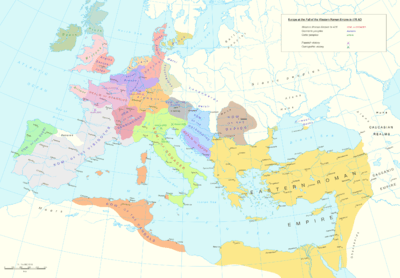
- 259, Battle of Mediolanum—Emperor Gallienus defeats the Alemanni to rescue Rome
- 268, Battle of Lake Benacus—Romans under Emperor Claudius II defeat the Alemanni.
- 271
- Battle of Placentia—Emperor Aurelian is defeated by the Alemanni forces invading Italy
- Battle of Fano—Aurelian defeats the Alemanni, who begin to retreat from Italy
- Battle of Pavia—Aurelian destroys the retreating Alemanni army.
- 298
- Battle of Lingones—Caesar Constantius Chlorus defeats the Alemanni
- Battle of Vindonissa—Constantius defeats the Alemanni.
- 356, Battle of Reims—Caesar Julian is defeated by the Alemanni
- 357, Battle of Strasbourg—Julian expels the Alemanni from the Rhineland
- 368, Battle of Solicinium—Romans under Emperor Valentinian I defeat an Alemanni incursion.
- 378, Battle of Argentovaria—Western Emperor Gratianus is victorious over the Alemanni.
- 451, Battle of the Catalaunian Fields-Roman General Aetius and his army of Romans and barbarian allies defeat Attila's army of Huns and other Germanic allies, including the Alemanni.
- 457, Battle of Campi Cannini, Alemanni invade Italy and are defeated near Lake Maggiore by Majorian
- 554, Battle of the Volturnus-Armenian-Roman General Narses defeats a combined force of Franks and Alemanni in southern Italy.
Subjugation by the Franks
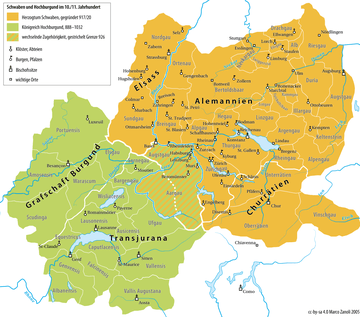
The kingdom of Alamannia between Strasbourg and Augsburg lasted until 496, when the Alemanni were conquered by Clovis I at the Battle of Tolbiac. The war of Clovis with the Alemanni forms the setting for the conversion of Clovis, briefly treated by Gregory of Tours. (Book II.31) Subsequently, the Alemanni formed part of the Frankish dominions and were governed by a Frankish duke.
In 746, Carloman ended an uprising by summarily executing all Alemannic nobility at the blood court at Cannstatt, and for the following century, Alemannia was ruled by Frankish dukes. Following the treaty of Verdun of 843, Alemannia became a province of the eastern kingdom of Louis the German, the precursor of the Holy Roman Empire. The duchy persisted until 1268.
Culture
Language

The German spoken today over the range of the former Alemanni is termed Alemannic German, and is recognised among the subgroups of the High German languages. Alemannic runic inscriptions such as those on the Pforzen buckle are among the earliest testimonies of Old High German. The High German consonant shift is thought to have originated around the 5th century either in Alemannia or among the Lombards; before that the dialect spoken by Alemannic tribes was little different from that of other West Germanic peoples.[19]
Alemannia lost its distinct jurisdictional identity when Charles Martel absorbed it into the Frankish empire, early in the 8th century. Today, Alemannic is a linguistic term, referring to Alemannic German, encompassing the dialects of the southern two thirds of Baden-Württemberg (German State), in western Bavaria (German State), in Vorarlberg (Austrian State), Swiss German in Switzerland and the Alsatian language of the Alsace (France).
Political organization
The Alemanni established a series of territorially defined pagi (cantons) on the east bank of the Rhine. The exact number and extent of these pagi is unclear and probably changed over time.
Pagi, usually pairs of pagi combined, formed kingdoms (regna) which, it is generally believed, were permanent and hereditary. Ammianus describes Alemanni rulers with various terms: reges excelsiores ante alios ("paramount kings"), reges proximi ("neighbouring kings"), reguli ("petty kings") and regales ("princes"). This may be a formal hierarchy, or they may be vague, overlapping terms, or a combination of both.[20] In 357, there appear to have been two paramount kings (Chnodomar and Westralp) who probably acted as presidents of the confederation and seven other kings (reges). Their territories were small and mostly strung along the Rhine (although a few were in the hinterland).[21] It is possible that the reguli were the rulers of the two pagi in each kingdom. Underneath the royal class were the nobles (called optimates by the Romans) and warriors (called armati by the Romans). The warriors consisted of professional warbands and levies of free men.[22] Each nobleman could raise an average of c. 50 warriors.[23]
Religion


The Christianization of the Alemanni took place during Merovingian times (6th to 8th centuries). We know that in the 6th century, the Alemanni were predominantly pagan, and in the 8th century, they were predominantly Christian. The intervening 7th century was a period of genuine syncretism during which Christian symbolism and doctrine gradually grew in influence.
Some scholars have speculated that members of the Alemannic elite such as king Gibuld due to Visigothic influence may have been converted to Arianism even in the later 5th century.[25]
In the mid-6th century, the Byzantine historian Agathias records, in the context of the wars of the Goths and Franks against Byzantium, that the Alemanni fighting among the troops of Frankish king Theudebald were like the Franks in all respects except religion, since
they worship certain trees, the waters of rivers, hills and mountain valleys, in whose honour they sacrifice horses, cattle and countless other animals by beheading them, and imagine that they are performing an act of piety thereby.[26]
He also spoke of the particular ruthlessness of the Alemanni in destroying Christian sanctuaries and plundering churches while the genuine Franks were respectful towards those sanctuaries. Agathias expresses his hope that the Alemanni would assume better manners through prolonged contact with the Franks, which is by all appearances, in a manner of speaking, what eventually happened.[27]
Apostles of the Alemanni were Columbanus and his disciple Saint Gall. Jonas of Bobbio records that Columbanus was active in Bregenz, where he disrupted a beer sacrifice to Wodan. Despite these activities, for some time, the Alemanni seem to have continued their pagan cult activities, with only superficial or syncretistic Christian elements. In particular, there is no change in burial practice, and tumulus warrior graves continued to be erected throughout Merovingian times. Syncretism of traditional Germanic animal-style with Christian symbolism is also present in artwork, but Christian symbolism becomes more and more prevalent during the 7th century. Unlike the later Christianization of the Saxons and of the Slavs, the Alemanni seem to have adopted Christianity gradually, and voluntarily, spread in emulation of the Merovingian elite.
From c. the 520s to the 620s, there was a surge of Alemannic Elder Futhark inscriptions. About 70 specimens have survived, roughly half of them on fibulae, others on belt buckles (see Pforzen buckle, Bülach fibula) and other jewelry and weapon parts. Use of runes subsides with the advance of Christianity. The Nordendorf fibula (early 7th century) clearly records pagan theonyms, logaþorewodanwigiþonar read as "Wodan and Donar are magicians/sorcerers", but this may be interpreted as either a pagan invocation of the powers of these deities, or a Christian protective charm against them.[28] A runic inscription on a fibula found at Bad Ems reflects Christian pious sentiment (and is also explicitly marked with a Christian cross), reading god fura dih deofile ᛭ ("God for/before you, Theophilus!", or alternatively "God before you, Devil!"). Dated to between AD 660 and 690, it marks the end of the native Alemannic tradition of runic literacy. Bad Ems is in Rhineland-Palatinate, on the northwestern boundary of Alemannic settlement, where Frankish influence would have been strongest.[29]
The establishment of the bishopric of Konstanz cannot be dated exactly and was possibly undertaken by Columbanus himself (before 612). In any case, it existed by 635, when Gunzo appointed John of Grab bishop. Constance was a missionary bishopric in newly converted lands, and did not look back on late Roman church history unlike the Raetian bishopric of Chur (established 451) and Basel (an episcopal seat from 740, and which continued the line of Bishops of Augusta Raurica, see Bishop of Basel). The establishment of the church as an institution recognized by worldly rulers is also visible in legal history. In the early 7th century Pactus Alamannorum hardly ever mentions the special privileges of the church, while Lantfrid's Lex Alamannorum of 720 has an entire chapter reserved for ecclesial matters alone.
Genetics
A genetic study published in Science Advances in September 2018 examined the remains of eight individuals buried at a 7th century Alemannic graveyard in Niederstotzingen, Germany. This is the richest and most complete Alemannic graveyard ever found. The highest ranking individual at the graveyard was a male with Frankish grave goods. Four males were found to be closely related to him. They were all cariers of types of the paternal haplogroup R1b1a2a1a1c2b2b. A sixth male was a carrier of the paternal haplogroup R1b1a2a1a1c2b2b1a1 and the maternal haplogroup U5a1a1. Along with the five closely related individuals, he displayed close genetic links to northern and eastern Europe, particularly Lithuania and Iceland. Two individuals buried at the cemetery were found to be genetically different from both the others and each other, displaying genetic links to Southern Europe, particularly northern Spain. Along with the sixth male, they might have been adoptees.[30]
See also
- Annales Alamannici
- List of rulers of Alamannia
- List of confederations of Germanic tribes
- Armalausi
- Varisci
- Helvetii
References
- The spelling with "e" is used in Encyc. Brit. 9th. ed., (c. 1880), Everyman's Encyc. 1967, Everyman's Smaller Classical Dictionary, 1910. The current edition of Britannica spells with "e", as does Columbia and Edward Gibbon, Vol. 3, Chapter XXXVIII. The Latinized spelling with a is current in older literature (so in the 1911 Britannica), but remains in use e.g. in Wood (2003), Drinkwater (2007).
- The Alemanni were alternatively known as Suebi from about the fifth century, and that name became prevalent in the high medieval period, eponymous of the Duchy of Swabia. The name is taken from that of the Suebi mentioned by Julius Caesar, and although these older Suebi did likely contribute to the ethnogenesis of the Alemanni, there is no direct connection to the contemporary Kingdom of the Suebi in Galicia.
-
- Drinkwater, John Frederick (2012). "Alamanni". In Hornblower, Simon; Spawforth, Antony; Eidinow, Esther (eds.). The Oxford Classical Dictionary (4 ed.). Oxford University Press. ISBN 9780191735257. Retrieved January 26, 2020.
Alamanni (Alemanni), a loose concentration of Germanic communities...
- Hitchner, R. Bruce (2005). "Goths". In Kazhdan, Alexander P. (ed.). The Oxford Dictionary of Byzantium. Oxford University Press. ISBN 9780195187922. Retrieved January 26, 2020.
Alemanni... the Latin term for an amalgamation of a number of smaller Germanic tribes, including a segment of the Suevi.
- Darvill, Timothy, ed. (2009). "Alamanni". The Concise Oxford Dictionary of Archaeology (3 ed.). Oxford University Press. ISBN 9780191727139. Retrieved January 25, 2020.
Alamanni. A confederation of several Germanic tribes who amalgamated in the 3rd century ad.
- Drinkwater, John Frederick (2012). "Alamanni". In Hornblower, Simon; Spawforth, Antony; Eidinow, Esther (eds.). The Oxford Classical Dictionary (4 ed.). Oxford University Press. ISBN 9780191735257. Retrieved January 26, 2020.
- in pago Almanniae 762, in pago Alemannorum 797, urbs Constantia in ducatu Alemanniae 797; in ducatu Alemannico, in pago Linzgowe 873. From the 9th century, Alamannia is increasingly used of the Alsace specifically, while the Alamannic territory in generally is increasingly called Suebia; by the 12th century, the name Suebia had mostly replaced Alamannia. S. Hirzel, Forschungen zur Deutschen Landeskunde 6 (1888), p. 299.
- recorded as aleman in c. 1100, and with final dental, alemant or alemand, from c. 1160. Trésor de la Langue Française informatisé s.v. allemand.
- F.C. and J. Rivington, T. Payne, Wilkie and Robinson: The Chronicle of Iohn Hardyng, 1812, p. 99.
- H. Kurath: Middle English Dictionary, part 14, University of Michigan Press, 1952, 1345.
-

- Edward Gibbon. "Chapter 10". Ccel.org. Retrieved 2012-01-02.
- Histoire de l'Académie Royale des Inscriptions et Belles-Lettres, avec les Mémoires de Littérature tirés des Registres de cette Académie, depuis l'année MDCCXLIV jusques et compris l'année MDCCXLVI, vol. XVIII, (Paris 1753) pp. 49–71. Excerpts are on-line at ELIOHS.
- It is cited in most etymological dictionaries, such as the American Heritage Dictionary (large edition) under the root, *man- Archived 2006-05-19 at the Wayback Machine.
- "the name is possibly Alahmannen, 'men of the sanctuary'" Inglis Palgrave (ed.), The Collected Historical Works of Sir Francis Palgrave, K.H. (1919), p. 443 (citing: "Bury's ed. of Gibbon (Methuen), vol. I [1902], p. 278 note; H. M. Chadwick, Origin of the English Nation [1907]").
- Igitur quia mixti Alamannis Suevi, partem Germaniae ultra Danubium, partem Raetiae inter Alpes et Histrum, partemque Galliae circa Ararim obsederunt; antiquorum vocabulorum veritate servata, ab incolis nomen patriae derivemus, et Alamanniam vel Sueviam nominemus. Nam cum duo sint vocabula unam gentem significantia, priori nomine nos appellant circumpositae gentes, quae Latinum habent sermonem; sequenti, usus nos nuncupat barbarorum. Walafrid Strabo, Proleg. ad Vit. S. Galli (833/4) ed. Migne (1852); Thomas Greenwood, The First Book of the History of the Germans: Barbaric Period (1836), p. 498.
- Rudolf Much, Der germanische Himmelsgott (1898), p. 192.
- "Cassius Dio: Roman History". University of Chicago.
- "Historia Augusta: The Life of Antoninus Caracalla". University of Chicago.
- munimentum quod in Alamannorum solo conditum Traianus suo nomine voluit appellari.
- Ptolemy's description has some limitations. Upper Germany and Lower Germany are mentioned by name, but only as specific districts of Gallia Belgica (2.8), the border between them was an unidentified river, the Obruncus. The region is repeated again under Germany, but this time he does not list Roman boundaries. Germania Superior, the Agri Decumates and the limes are not to be found there, though they certainly existed at the time. "Germania Magna" is found within the Rhine, Danube, Vistula and shores of the "Oceanus Germanicus". Most of the tribes are missing or listed without name. The Main is not there, nor is Lake Constance. The Danube runs from the Alps. The Rhine does not bend to the south next to Swabia. Ptolemy's Germania is like a surreal image of itself, accurate only if certain known lines are followed, but the overall shape is greatly distorted.
- "Alamanni/Alemanni (= Suebi/Suevi, Semnones) | Freyia Völundarhúsins" (in Norwegian Bokmål). Retrieved 2019-04-29.
- Drinkwater (2007) 118, 120
- Drinkwater (2007) 223 (map)
- Speidel (2004)
- Drinkwater (2007) 120
- Michael Speidel, Ancient Germanic warriors: warrior styles from Trajan's column to Icelandic sagas, Routledge, 2004, ISBN 978-0415311991, p. 162. Harald Kleinschmidt, People on the move: attitudes toward and perceptions of migration in medieval and modern Europe, Greenwood Publishing Group, 2003, ISBN, 9780275974176, p. 66.
- Schubert, Hans (1909). Das älteste germanische Christentum oder der Sogenannte "Arianismus" der Germanen. Tübingen: J.C.B. Mohr. pg.32. Cf. also Bossert, G. "Alemanni" in: Jackson, S.M. (Ed.). New Schaff-Herzog Encyclopedia of Religious Knowledge, Vol. 1, pg. 114: "[the Alamannic] prince, Gibuld, was an Arian, probably converted by Goths".
- trans. Joseph D. Frendo (1975). Books.google.com. 1975. ISBN 9783110033571. Retrieved 2012-01-02.
- R. Keydell, Agathiae Myrinaei historiarum libri quinque Corpus Fontium Historiae Byzantinae. Series Berolinensis 2. Berlin: De Gruyter, 1967, p. 18f. 7. Νόμιμα δὲ αὐτοῖς [τῶν Ἀλαμανῶν ἔθνος] εἰσι μέν που καὶ πάτρια, τὸ δέ γε ἐν κοινῷ ἐπικρατοῦν τε καὶ ἄρχον τῇ Φραγγικῇ ἕπονται πολιτείᾳ, μόνα δέ γε τὰ ἐς (5) θεὸν αὐτοῖς οὐ ταὐτὰ ξυνδοκεῖ. δένδρα τε γάρ τινα ἱλάσκονται καὶ ῥεῖθρα ποταμῶν καὶ λόφους καὶ φάραγγας, καὶ τούτοις, ὥσπερ ὅσια δρῶντες, ἵππους τε καὶ βόας καὶ ἄλλα ἄττα μυρία καρατομοῦντες ἐπιθειάζουσιν. 2 ἀλλὰ γὰρ ἡ τῶν Φράγγων αὐτοὺς ἐπιμιξία, εnὖ ποιοῦσα, καὶ ἐς τόδε μετακοσμεῖ καὶ ἤδη ἐφέλκεται τοὺς εὐφρονεστέρους, οὐ πολλοῦ δὲ οἶμαι (10) χρόνου καὶ ἅπασιν ἐκνικήσει. 3 τὸ γὰρ τῆς δόξης παράλογόν τε καὶ ἔμπληκτον καὶ αὐτοῖς οἶμαι τοῖς χρωμένοις, εἰ μὴ πάμπαν εἶεν ἠλίθιοι, γνώριμόν τέ ἐστι καὶ εὐφώρατον καὶ οἶον ἀποσβῆναι ῥᾳδίως. ἐλεεῖσθαι μὲν οὖν μᾶλλον ἢ χαλεπαίνεσθαι δίκαιοι ἂν εἶεν καὶ πλείστης μεταλαγχάνειν συγγνώμης ἅπαντες, ὅσοι δὴ τοῦ ἀληθοῦς ἁμαρτάνουσιν. οὐ γὰρ (15) δήπου ἑκόντες εἶναι ἀλῶνται καὶ ὀλισθαίνουσιν, ἀλλὰ τοῦ ἀγαθοῦ ἐφιέμενοι, ἔπειτα σφαλέντες τῇ κρίσει τὸ λοιπὸν ἔχονται τῶν δοκηθέντων ἀπρίξ, ὁποῖα ἄττα καὶ τύχοιεν ὄντα. 4 τήν γε μὴν τῶν θυσιῶν ὠμότητα καὶ κακοδαιμονίαν οὐκ οἶδα εἰ οἷόν τε λόγῳ ἀκέσασθαι, εἴτε ἄλσεσιν ἐπιτελοῖντο ὥσπερ ἀμέλει παρὰ βαρβάροις, εἴτε τοῖς πάλαι νενομισμέ-(20)νοις θεοῖς, ὁποῖα αἱ τῶν Ἑλλήνων ἐθέλουσιν ἁγιστεῖαι.
- Düwel, Klaus (1982). "Runen und Interpretatio Christiana: Zur Religioneschichtlichen Stellung der Bügelfidel von Nordendorf I". In Kamp, Norbert; Wollasch, Joachim (eds.). Tradition als Historische Kraft. Walter de Gruyter. pp. 78–86. ISBN 311-008237-3.
- Wolfgang Jungandreas, 'God fura dih, deofile †' in: Zeitschrift für deutsches Altertum und deutsche Literatur, 101, 1972, pp. 84–85.
- O’Sullivan et al. 2018: "Genome-wide analyses were performed on eight individuals to estimate genetic affiliation to modern west Eurasians and genetic kinship at the burial. Five individuals were direct relatives. Three other individuals were not detectably related; two of these showed genomic affinity to southern Europeans... These five related individuals had culturally diverse grave goods despite the evidence that all of them showed local isotope signals with northern European genetic affiliations... Niederstotzingen North individuals are closely related to northern and eastern European populations, particularly from Lithuania and Iceland."
Sources
- Ammianus Marcellinus, passim
- O. Bremer in H. Paul, Grundriss der germanischen Philologie (2nd ed., Strassburg, 1900), vol. iii. pp. 930 ff.
- Dio Cassius lxvii. ff.
- Drinkwater, J. F. (2007) The Alamanni and Rome (213–496)
- Ian Wood (ed.), Franks and Alamanni in the Merovingian Period: An Ethnographic Perspective (Studies in Historical Archaeoethnology), Boydell & Brewer Ltd, 2003, ISBN 1-84383-035-3.
- Melchior Goldast, Rerum Alamannicarum scriptores (1606, 2nd ed. Senckenburg 1730)
- Gregory of Tours, Historia Francorum, book ii.
- O’Sullivan, Niall; et al. (September 5, 2018). "Ancient genome-wide analyses infer kinship structure in an Early Medieval Alemannic graveyard". Science Advances. American Association for the Advancement of Science. 4 (9). doi:10.1126/sciadv.aao1262. PMC 6124919. PMID 30191172. Retrieved April 4, 2020.
- C. Zeuss, Die Deutschen und die Nachbarstämme (Munich, 1837), pp. 303 ff.
External links
![]()
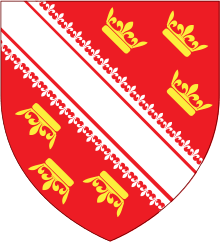
.svg.png)